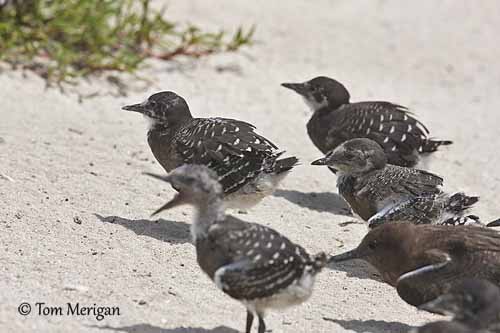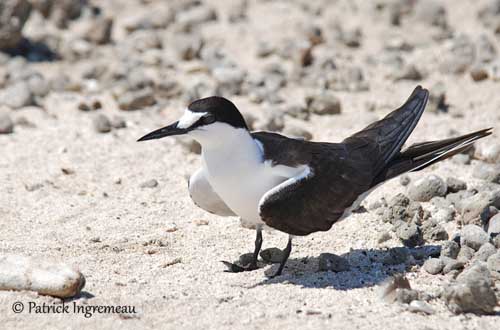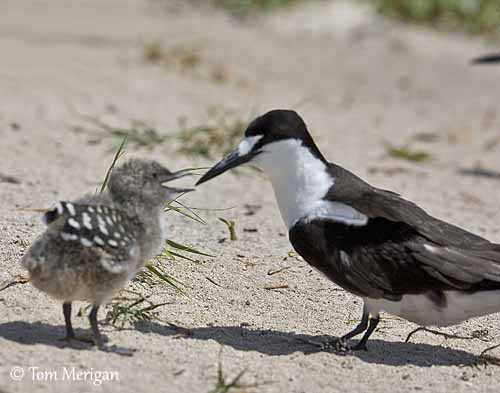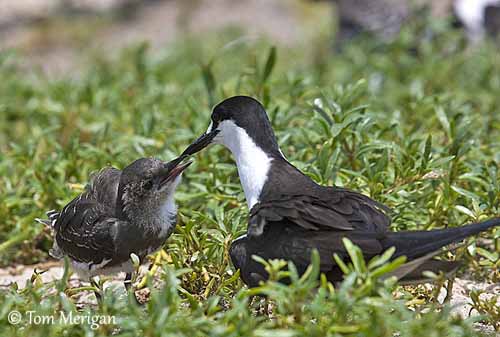
Fr: Sterne fuligineuse
All : Rußseeschwalbe
Esp : Charrán Sombrío
Ital : Rondine di mare oscura
Nd: Bonte Stern
Sd: Sottärna
Photographers:
Patrick Ingremeau
TAMANDUA
Tom Merigan
Tom Merigan’s Photo Galleries
Text by Nicole Bouglouan
Sources:
HANDBOOK OF THE BIRDS OF THE WORLD Volume 3 by Josep del Hoyo-Andrew Elliott-Jordi Sargatal - Lynx Edicions - ISBN : 8487334202
A Field Guide to the Birds of South-East Asia by Craig Robson. New Holland Publishers. ISBN: 9781780090498
BirdLife International (BirdLife International)
SORA Searchable Ornithological Research Archive (Blair O. Wolf)
Sooty tern
Onychoprion fuscatus
Charadriiforme Order – Laridae Family
BIOMETRICS:
Length: 36-45 cm
Wingspan: 82-94 cm
Weight: 150-240 g (average 173-190g)
DESCRIPTION:
The Sooty Tern is a seabird of the tropical oceans. This black and white tern is very noisy, and its other English names come from its main call” ker-wacki-wah”, and they vary according to the range from “wideawake” to “ewa ewa”.
In breeding plumage, the adult has blackish crown and hindneck, and upperparts. The black tail is deeply forked and shows white outer rectrices.
The underparts are white with blackish flight feathers. The wings are long. In flight, we can see a white leading edge and a black trailing edge.
On the head, crown and nape are black. There is a black line from bill to eye. The face is white.
Bill, legs and webbed feet are black. The eyes are dark brown.

The adult in non-breeding plumage has variable amount of white-edged feathers on the upperparts. The black crown is slightly and finely mottled white.
Both sexes are similar.
The juvenile is rather blackish-brown above and below, except on the whitish vent. The upperparts show white-tipped feathers. The head is sooty-blackish.
The chick has blackish-brown down above and white below. The head is dark.

We can find eight subspecies sharing the wide tropical range. They differ only slightly.
VOICE: SOUNDS BY XENO-CANTO
The Sooty Tern is a noisy bird. At the breeding colony, they give high-pitched yelping calls “wide-a-wake”, and shorter “kraark”. Calling is incessant at colonies.

HABITAT:
The Sooty Tern occurs in waters rich in plankton, fish and squid. This species avoids the cold-current areas.
The breeding grounds are on oceanic islands, and barrier islands of sand, rock or coral. Artificial islands structures are also used. These islands are usually flat and open, and often heavily vegetated.
Outside the breeding season, the Sooty Tern is highly pelagic. It can be vagrant inland after storms and hurricanes.

RANGE:
The Sooty Tern occurs in tropical and subtropical waters of Americas, Africa, Asia and Australia. The terns leave the breeding colonies once the chicks fledge.
The birds from West Indies disperse into Gulf of Mexico and Caribbean where they may winter.
The juveniles move south down across the Atlantic Ocean to reach the African coasts.
The populations of Indian Ocean probably disperse widely throughout the range.
The Pacific adults disperse between June and October, and begin to return in late November.

BEHAVIOUR:
The Sooty Tern feeds on fish, squid and crustaceans when at sea, and occasionally insects and offal.
It feeds by using several techniques such as aerial-dipping, skimming over water or contact-dipping, and rarely plunge-diving. The flying fish is caught in the air.
This species also feeds at night, taking fish coming to the surface in darkness.
This tern cannot swim and rarely rests on water because its plumage is not water-repellent. It becomes waterlogged and the bird is not able to take off.
It is known for taking short naps of 1-2 seconds while flying. This peculiarity allows the Sooty Tern to stay in the air. Between the end of the fledging period and the first breeding (4-5 years), they do not visit land and reach the islands only for nesting.

The breeding season is not synchronous among the members of a colony. Some breeding occurs at any time of the year at a given colony, as on some tropical islands.
The breeding of the Sooty Tern can occur at intervals of 6-7 months in some parts of the range, whereas the Caribbean colonies have an annual cycle.
They breed in huge colonies on islands, and some breeding sites are known to be occupied for several centuries. The nests are very close to each other. They are territorial and defend the small area. Such huge agglomeration of birds is a protection, because the aerial predators cannot land.
Courtship displays and copulation are usually synchronous. The displays are performed both on the ground and in the air. But prior to copulation, the mates circle around each other with slightly dropped wings and bill pointed downwards. They call softly. The copulation often follows these displays.

FLIGHT:
The Sooty Tern has swift, buoyant, graceful flight. The bird is assumed to sleep while flying. They also perform graceful soaring flight when they reach the open ocean.

REPRODUCTION:
The breeding season can be annual or seasonal according to the place.
The Sooty Tern nests in large or huge colonies on flat sites such as open sand, shell, rock or coral with vegetation. They usually prefer vegetal cover but they lay on bare grounds. The nest is often a slight depression and the nests are about 50 cm apart.

The female lays usually a single whitish egg. The incubation lasts 28-30 days, shared by both parents. The chicks are fed by regurgitation. The adults return to the nest with fish and squid in the crop, and they regurgitate the food directly into the chick’s bill. The young fledge at two months.

When the colony is established on bare ground, several chicks may die from heat exposure.
In many places, the first laying is collected for consumption.
DIET:
The Sooty Tern feeds mainly on fish, squid and crustaceans, and occasionally on insects and offal.
PROTECTION / THREATS / STATUS:
The Sooty Tern’s populations are not currently threatened.
However, predation by introduced cats and rats is a threat in some areas. The species is vulnerable to weather conditions and climatic change, oil-pollution, and the persistent egg-collecting in some areas which encourages the terns to move to less suitable nest-sites involving reduced breeding success.
